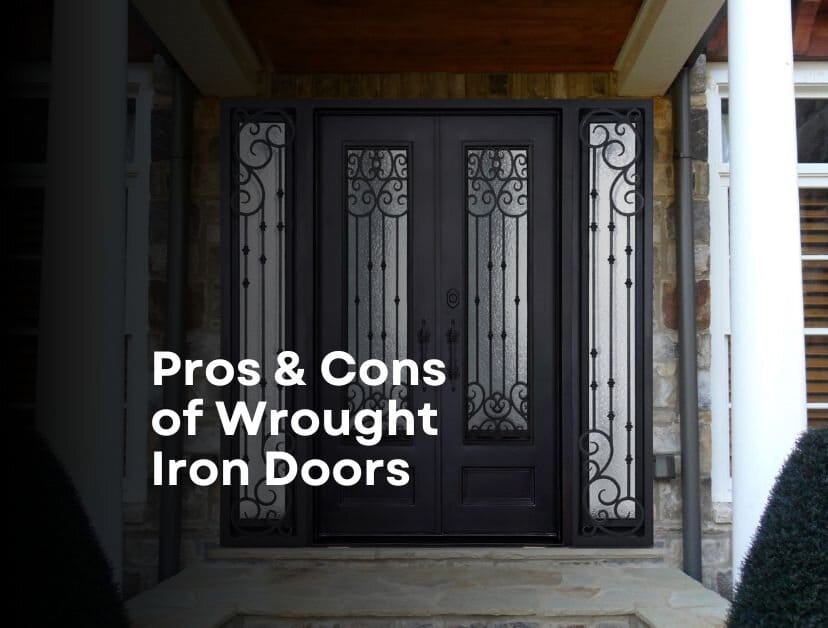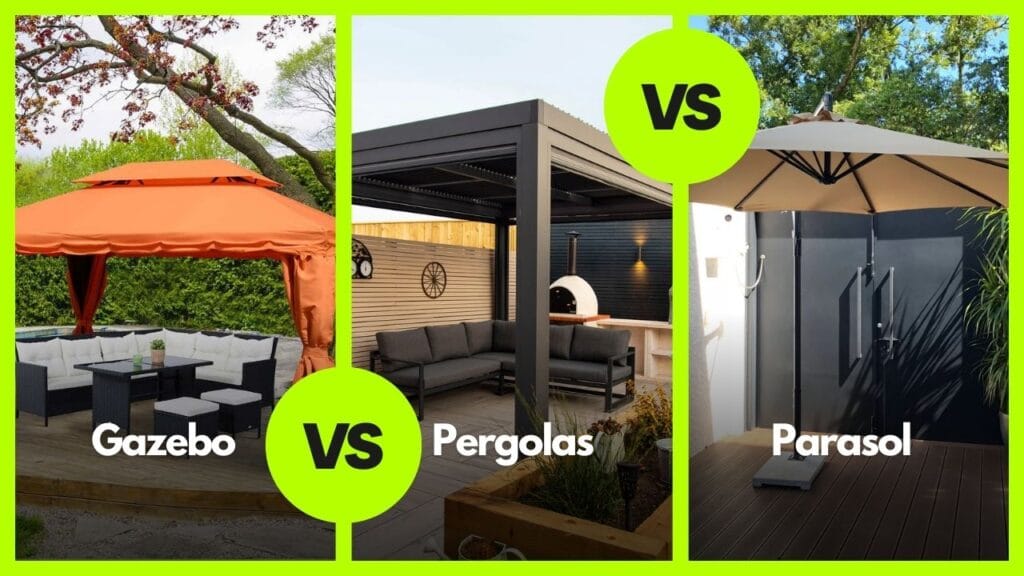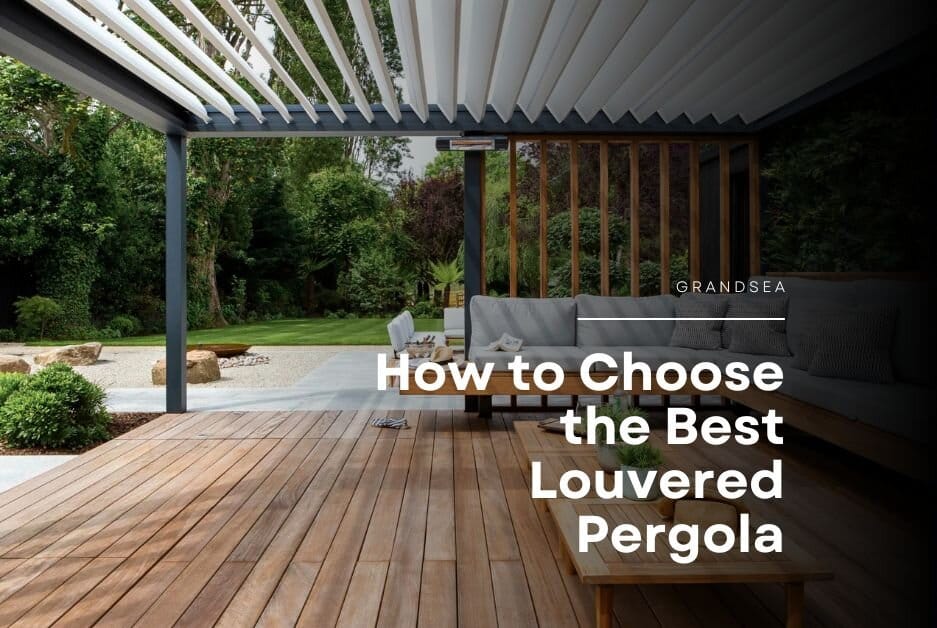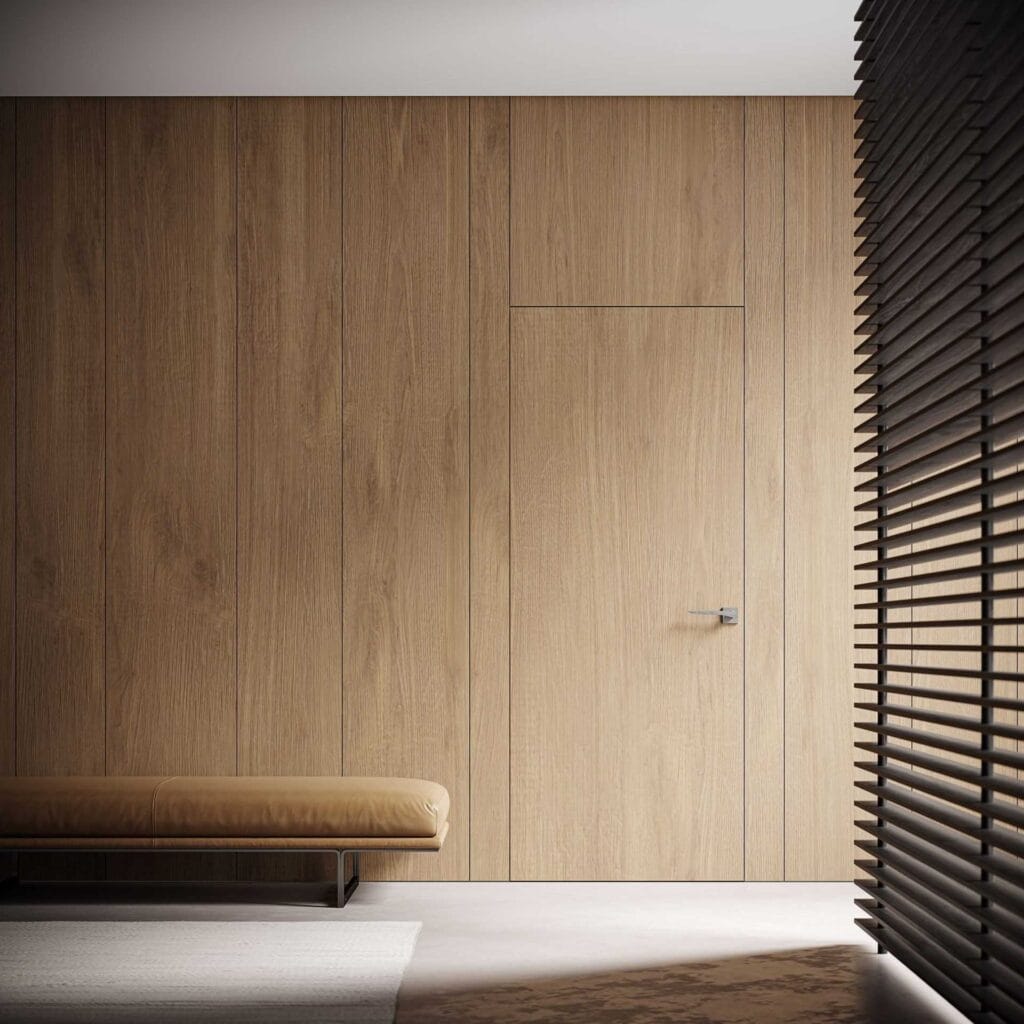Pros & Cons of Wrought Iron Doors

Wrought iron doors offer both timeless beauty and artistic appeal, seamlessly blending classical and modern styles. While their strength and security are widely recognized, their intricate geometric patterns make them a preferred choice for enhancing a home’s facade. Beyond their visual appeal, these doors provide numerous practical benefits. This article reviews the key features and main advantages of wrought iron doors, comparing them to alternatives like steel and wood to help you make an informed purchase decision. What is the paramount quality of wrought iron doors? Wrought iron doors are special because of their distinctive qualities. Let’s examine them now Superior strength and durability Wrought iron doors are renowned for their exceptional strength and durability. Crafted from high-quality iron, they withstand extreme heat and storms, making them highly resistant to harsh weather. Over time, a natural patina forms, acting as a rust barrier and further enhancing longevity. As a result, these doors can last for generations with minimal maintenance. Unrivalled Beauty Appeal Wrought iron doors are available in a wide range of artistic styles, from modern to traditional. Their versatility allows them to complement any architectural design, whether you prefer sleek lines or intricate patterns. Options such as double doors and glass-integrated models combine security with elegant aesthetics, offering both style and functionality. Low Maintenance Requirements Wrought iron doors require minimal maintenance compared to wooden alternatives. They do not need frequent sanding, sealing, or repainting. Occasional touch-ups help prevent rust and preserve their appearance, saving you both time and money without sacrificing security or style. Safety Features Wrought iron security doors are among the most secure options for homes, thanks to their heavy and robust construction. Paired with advanced locking systems, they offer exceptional resistance to forced entry and provide a high level of protection for your property Wrought Iron Door Advantages Enhances home value Wrought iron doors serve as both functional elements and artistic statements, enhancing a home’s exterior and curb appeal. Installing these doors can increase property value, making them a smart investment for homeowners seeking both beauty and long-term returns. Optimize the living experience Many wrought iron doors feature double or triple-pane glass, improving energy efficiency and allowing natural light to enter without compromising security. Some models include operable glass panels for adjustable ventilation, adding convenience and comfort for homeowners. Resistance to severe weather Wrought iron storm doors are designed to withstand severe weather, maintaining their structure and appearance even in heavy rain or strong winds. Unlike wooden doors, they do not crack or warp over time. Long-term cost savings Although wrought iron doors may have a higher upfront cost, their durability and low maintenance requirements make them a cost-effective choice over time. In contrast, wood and steel doors often require more frequent repairs or replacement due to wear and tear. Wrought iron doors are not perfect In the quest for elegance and practicality, we also need to be aware of the challenges that wrought iron doors can present The price of beauty Wrought iron doors tend to be more expensive than wood, fiberglass, or steel alternatives, especially when custom designs or intricate details are desired. Homeowners should consider their budget and weigh the long-term benefits against the initial investment. The weight issue The substantial weight of wrought iron doors contributes to their longevity and security but also makes installation more complex. Professional installation is usually required, which can add to the overall cost and time compared to lighter door materials. High-quality hinges and fittings are now common on many contemporary wrought iron doors. Their smoothness and usability are enhanced as a result. Although weight is a serious concern, it can be decreased with clever design. Rusting While wrought iron doors are durable, they can be susceptible to rust, especially in humid or coastal environments. Regular maintenance, such as applying protective coatings, is essential to prevent corrosion and preserve their appearance. Mediocre energy efficiency Wrought iron doors are not typically known for their insulation properties. However, newer models with improved sealing and insulated glass can enhance energy efficiency. Thermally broken frames can further reduce heat transfer, though these doors may still not insulate as effectively as fiberglass options. Wrought iron might require some modernization if you desire energy efficiency. It’s a wise purchase if longevity, style, and security are your top priorities. Better insulation could be possible, though. Comparison with front doors made of other materials Feature Wrought Iron Steel Wood Strength Extremely strong; resists force Very strong Moderate; prone to warping Durability Very long-lasting; rust-resistant with care Durable but can rust without proper finish Shorter lifespan; susceptible to rot Aesthetic Highly customizable; ornate & elegant Simple, modern designs; less flexible Warm, natural appearance Maintenance Low (occasional cleaning & touch-ups) Low to Moderate (depends on finish) High (requires regular sealing/painting) Security Excellent (heavy & robust) Excellent (strong material) Poor; easily damaged Cost High initial investment Moderate Moderate to High Energy Efficiency Moderate (can be improved with thermal breaks and insulated glass) High (with insulated core) Low Summary of Key Comparisons Let’s now examine the circumstances. Remember the following when contrasting wrought iron doors with alternative options: Compared to steel doors, wrought iron doors might be more expensive. But they look fantastic and are more resistant to rust. Although steel is robust, wrought iron’s intricate beauty and classic appeal are unmatched. Wooden Doors: Wood is less expensive and offers a cozier, more organic appearance. However, wrought iron’s strength and ease of use are unmatched. Wrought iron needs less upkeep and just sporadic touch-ups than wood. Choose wrought iron for a door that blends flair and security. It looks fantastic and lasts a long time. It’s a power move in addition to being a wise choice. Summary: Elegant and Practical Wrought iron doors offer a unique combination of security, durability, and sophisticated design. Their distinctive appearance and lasting quality make them a valuable addition to any home, providing both style and peace of mind for homeowners. Their sturdy build is weighty, and the initial outlay may be substantial. For those who appreciate luxury and a sophisticated lifestyle, these are not seen as problems. Instead,
Pergola VS Gazebo vs Parasol: Which is better?

Are you considering a pergola, gazebo, or parasol for your outdoor space? Each option can provide shade for a balcony, terrace, or garden dining area while enhancing the overall aesthetics of your home. Few additions offer as much comfort and visual appeal as these outdoor structures. This guide compiles essential information to help you choose the best option and make the most of your outdoor relaxation. Pergola VS Gazebo What distinguishes a pergola from a gazebo? While both structures enhance outdoor spaces, pergolas are primarily designed for weather protection during events like receptions and meals, whereas gazebos are often chosen for their decorative qualities. Pergola A pergola is a sturdy, decorative outdoor structure, typically rectangular and supported by four or six posts. Available in various materials, pergolas often feature a louvered roof that provides partial shade and ventilation. Some models are attached to a wall, creating an airy, sheltered area that protects your terrace from the elements. A pergola can partially cover a terrace, define the entrance to a specific area, or create a dedicated relaxation zone. Pergolas are often constructed from lightweight yet durable materials such as aluminum, and can be customized with features like privacy screens, integrated lighting, or blinds, making them both functional and visually appealing. Gazebo Gazebos are available in various shapes and sizes, with octagonal designs being particularly elaborate. Typically anchored to the garden or terrace with nails or screws, gazebos often feature steel frames and fabric roofs or curtains, with durability depending on material quality. They can accommodate garden furniture and offer protection from cool evenings or inclement weather. Models with UV-resistant polyethylene or polyester coverings add a modern touch, while open gazebos can support climbing plants such as jasmine, clematis, or wisteria. Advantages of a pergola A pergola can serve as a true summer retreat, creating a dedicated outdoor space. Wind-resistant models with adjustable louvers provide reliable protection from sun and rain, allowing you to enjoy your outdoor area throughout the year. Pergolas can be constructed from a variety of materials: Aluminum: Lightweight, corrosion-resistant, and highly durable. Epoxy-coated steel: Modern, minimalist, and resistant to corrosion. Wrought iron: Elegant and sturdy, though heavier and often attached to both wall and floor. Wood: Offers natural warmth and character; typically made from treated pine, acacia, or other durable species. Heavy wooden structures require secure anchoring and periodic anti-corrosion maintenance. Gazebo shapes Gazebos come in styles to suit any preference. For a Japanese-inspired look, select a wooden gazebo complemented by bamboo and exotic plants. For a romantic, English garden style, opt for a hexagonal or round wooden gazebo adorned with pale climbing roses, jasmine, or honeysuckle. Pergola VS Parasol Which is suitable for your space: pergola, gazebo, or parasol? Pergolas are best suited for large terraces or open garden areas, as their size and structure require ample space. Parasols, especially newer rectangular models, are versatile enough for both large and small balconies. They can be placed between garden furniture, in the center of a table, or alongside seating areas, making them a convenient, all-purpose shade solution. Which is quicker to set up: parasol or pergola? Parasols are generally quicker and easier to assemble, typically requiring only a filled base and simple adjustments. Many modern models feature a crank mechanism for effortless opening and closing. Pergolas, even when purchased as kits, require more time for assembly and component organization. Overall, parasols are the faster option to set up. Which offers better wind and rain protection: parasol or pergola? A parasol relies on a heavy base for stability but should always be positioned to avoid strong winds. Pergolas must be securely anchored to the ground or terrace, especially in windy conditions. Models with adjustable louvers and integrated drainage systems provide superior protection against both wind and rain, creating a comfortable outdoor gathering space. If neither option meets your needs, a gazebo may be the ideal alternative. Umbrella or pergola: advantages and disadvantages at a glance Advantages Disadvantages pergola Better water resistance Upright position on four legs, larger footprint Can be closed with a side curtain Mostly fixed installation Suitable for larger areas Long assembly and disassembly times Removable fabric, sold separately Limited choice of colors and patterns Looks very decorative in the garden Parasol Easy to transport and store Poor water resistance Requires less space as it only has one leg Few fabrics can be removed Tiltable and height-adjustable Feet or boards need to be purchased More colors and patterns to choose from Not very decorative Conclusion There is no single answer to which is best—pergola, gazebo, or parasol—as the right choice depends on your outdoor space, functional needs, and budget. Parasols offer the most economical and flexible solution, while pergolas provide enhanced shelter and a permanent feature. Gazebos combine decorative appeal with practical benefits. Whichever you choose, adding a pergola or gazebo will enhance your outdoor living area and can increase your home’s value. In any case, adding a gazebo or pergola will enhance your outdoor area and immediately add value to your home. So what are you waiting for? Get started now! You may enjoy these related articles: Top 10 best pergola manufacturers louvered pergolas Cost: Everything You Need to Know How to install an aluminum pergola? Which pergola is better: a louvre roof or a retractable roof? Aluminum or Wood Pergolas – Which One Fits Your Needs Buying or building a pergola? How to Choose the Best Louvered Pergola for Your Backyard How to find the right pergola? Best Tips for Personalizing Your Custom Pergola How should I design my pergola? What size should I choose when buying a pergola?
How to Choose the Best Louvered Pergola for Your Backyard

Imagine transforming your backyard into a relaxing and stylish retreat. A louvered pergola can make this vision a reality by offering adjustable slats that let you control light, shade, and airflow. On hot days, tilting the slats increases ventilation, while fully closing them provides protection from harmful UV rays and rain. This flexibility ensures your outdoor plans are never disrupted, and the modern design enhances both the functionality and appearance of your backyard. Understanding Louvered Pergolas What is a Louvered Pergola? A louvered pergola is a modern outdoor structure featuring adjustable slats, setting it apart from traditional pergolas with fixed beams. These movable slats allow you to control sunlight, shade, and airflow, making the pergola adaptable to changing weather conditions. When fully closed, the slats provide shelter from rain, while partially open settings offer customized light and ventilation. Compared to wooden pergolas, aluminum models are particularly easy to maintain, combining practicality with contemporary style. These features make louvered pergolas stylish and useful. Benefits of Louvered Pergolas Sunlight and Shade Control Louvered pergolas offer precise control over sunlight and shade by allowing you to tilt the slats to your preferred angle. This flexibility helps you stay cool and protected from the sun, making your outdoor space comfortable even on the hottest days. Better Outdoor Living A louvered pergola enhances your outdoor living experience by creating a comfortable, inviting space for dining, relaxing, or entertaining guests. Whether installed by the pool or on a deck, it transforms your backyard into a versatile area for year-round enjoyment. Strong and Long-Lasting Louvered pergolas are constructed from durable materials such as aluminum and steel, which resist rust and rot. Aluminum, in particular, is lightweight, strong, and requires minimal maintenance, allowing you to enjoy your pergola without frequent repairs. Why Pick a Louvered Pergola for Your Backyard? Louvered pergolas are great for many reasons. They protect you from sun, rain, and wind. The adjustable slats let you control light and shade. They also come in many styles to match your home. They make your backyard look better and more useful. Use one to create a cozy hangout, a dining area, or a shaded pool spot. A louvered pergola can turn your outdoor space into something amazing. Key Factors to Think About Size How Size Affects Cost and Use When choosing a louvered pergola, consider the size that best fits your outdoor space and budget. Larger pergolas provide more room for gatherings but require additional materials and higher installation costs. If you’re working with a limited budget or smaller area, a compact pergola can still offer comfort and functionality. Common Sizes and Their Uses Backyards come in all shapes and sizes. Pergolas are made to fit different spaces. Here’s a simple guide to match pergola sizes with backyards: Pergola SizeBest Backyard Fit 10×10 feet (3×3 m) Small or Medium Deck 16×16 feet (4.88×4.88 m) Large Deck 10×13 feet (3×4 m) Standalone Pergola 13×19 feet (4×6 m) Standalone Pergola Think about how you’ll use your pergola. Small ones are great for cozy spots. Bigger ones are better for parties or dining areas. Material Why Aluminum is a Great Option Aluminum is a popular choice for louvered pergolas due to its lightweight strength and resistance to rust and corrosion. It requires minimal maintenance—no painting or sealing—and can be easily cleaned with water, making it ideal for long-term outdoor use. Here’s why aluminum is popular: Doesn’t rust or corrode. No painting or sealing needed. Handles heavy snow and rain. Adjustable slats for all seasons. Durability and Care Tips Different materials need different care. Aluminum is almost no work and doesn’t fade or rust. Vinyl is easy to care for but might fade. Wood looks nice but needs sealing and staining often. Steel is very strong but can rust if untreated. If you want something easy to care for, pick aluminum. Features Motorized or Manual Slats Louvered pergolas are available with either manual or motorized slats. Motorized options allow you to adjust the slats effortlessly using a remote control or smart home integration, while manual models are more affordable but require physical adjustment. Why motorized slats are awesome: Easy to use with a remote or button. Control sunlight, shade, and airflow perfectly. Works with smart home systems. Built-in Extras like Lights and Sensors Modern pergolas often have cool extras. Some have LED lights for nighttime fun or heaters for cold evenings. Others have sensors that adjust slats automatically. For example, rain sensors close slats to keep you dry. Wind sensors protect the pergola during storms. These extras make your pergola more useful and easy to enjoy. Customization for Style Your pergola should match your taste. Many pergolas let you pick colors or add trims. You can add curtains for a cozy feel or go for a sleek design. Whether you like simple or fancy, customization helps your pergola fit your backyard perfectly. Cost Price Ranges for Pergola Sizes The price of a louvered pergola depends on its size, material, and additional features. For example, a 10’x10’ pergola typically ranges from $5,000 to $25,000, while larger models can exceed $80,000. Aluminum pergolas are generally the most expensive, followed by wood and vinyl options. Investing in extra features, such as motorized slats or integrated lighting, will also increase the overall cost. Material Average Cost Aluminum Highest Wood Moderate Vinyl Lowest What Affects the Price? Several things decide how much your pergola will cost. Here are the key factors: Size: Bigger pergolas need more materials and take longer to build. Material: Aluminum lasts long but costs more than wood or vinyl. Features: Extras like lights, sensors, or motorized slats raise the price. Labor Costs: Assembly costs depend on the design and material. Customization: Special colors, trims, or designs add to the cost. Location: Prices vary based on where you live and local markets. If you want a pergola with many features, it will cost more. Knowing these factors helps you avoid surprises. Save Money with DIY or Kits Want to spend less? Try
best hidden door ideas for upgrade your home

Hidden door designs, such as bookcase doors or those seamlessly integrated into walls, are highly flexible and can be tailored to your family’s needs. Whether due to specific functional needs, a desire for privacy, or simply to fulfill a childhood dream, hidden doors can be the perfect way to add a touch of understated luxury to your home. As an interior designer, Gavin from Grandsea Building said, “Besides reducing visual clutter, hidden doors enhance the interaction between architectural spaces.” At this time, we will delve into the variety of secret doors so that you may find in yourself the right inspiration to design your home full of mystery and elegance. Hidden Bookcase Door Just by flipping the pages of a book, a whole new world unfolds before you. In addition to being a bookshelf, this secret door is a passage; it can be placed in a study or living room and make you feel both scared and thrilled. A retro look with massive wooden bookshelves is an alternative way to go, while a modern and uncomplicated version with metal and glass materials, which is a combination of both, would be very practical and yet very dramatic. Hidden Pantry Door The hidden door in the kitchen blends seamlessly with the cabinets, and when opened, reveals ample storage space for food. This design not only saves space, but also makes the kitchen look more neat and organized. You can choose the same material and color as the cabinets, and even add some decorative lines to make the door completely “disappear” in the kitchen. Hidden Door Kit For those who enjoy DIY projects, the invisible door kit is an excellent choice. It provides all the necessary parts and detailed installation guides, so that you can easily create an invisible door. Whether it is a bookshelf door, a wall door or a sliding door, the kit can meet your needs, with simple installation and amazing results. Hidden Doors in Walls The invisible door is seamlessly integrated into the wall and opens to reveal a hidden space. This design is suitable for creating private spaces or hidden storage rooms, such as hidden cloakrooms, studies or entertainment rooms. You can choose the same color and material as the wall, and even add some decorative elements such as murals or wallpaper to make the door completely “disappear”. Hidden Pocket Door The sliding invisible door is completely hidden in the wall when it is folded, saving space while maintaining the overall beauty. This design is very suitable for small apartments, especially when you need to divide the space but don’t want to take up too much space. You can choose the same material and color as the wall, or use a mirror design to increase the visual extension of the space. Hidden Garage Door The garage door can also be invisible! The appearance is consistent with the exterior wall of the house, but it is a spacious garage when opened. This design is not only practical, but also improves the overall aesthetics of the house. You can choose the same material and color as the exterior wall, and even add some decorative elements, such as stone or wooden panels, to make the garage door completely “disappear” in the exterior of the building. Hidden Panel Door The invisible door on the wall, through clever design and decoration, the existence of the door is completely invisible. This design is suitable for creating a simple style home and maintaining the integrity of the space. You can choose the same material and color as the wall, or use some decorative lines and patterns to make the door completely “disappear” in the wall. Hidden Interior Doors Indoor invisible doors, perfectly integrated with the wall or furniture, maintaining the integrity of the space. This design is suitable for creating a simple style home, especially when you need to separate the space but don’t want to destroy the overall beauty. You can choose the same material and color as the wall, or use some decorative elements, such as murals or wallpaper, to make the door completely “disappear”. Hidden Sliding Doors Sliding invisible doors are completely hidden in the wall or behind the furniture when folded, saving space while maintaining overall beauty. This design is very suitable for modern home design, especially when you need to separate the space but don’t want to take up too much space. You can choose the same material and color as the wall, or use a mirror design to increase the visual extension of the space. Each hidden door design has its own unique charm and practicality. Choose a design that suits your home style to make your home more personalized and interesting. Whether it is to save space, increase privacy, or simply to add a sense of mystery, invisible doors can bring unexpected effects to your home design. Hidden interior door ideas Indoor hidden doors (Hidden Doors) are suitable for a variety of rooms and scenes because of their ingenious design and versatility. Here are some of the main rooms and reasons for using hidden doors: 1. Study or home office Applicable scenarios: Hidden Bookcase Door or wall invisible door. The study usually requires quietness and privacy. The invisible door can hide a secret space, such as a small lounge, storage room or even a hidden safe room. The design of bookshelf doors is particularly suitable for study rooms, which is both practical and mysterious. 2. Bedroom Applicable scenarios: wall invisible doors or sliding invisible doors (Hidden Sliding Doors). The bedroom may need to hide a cloakroom, bathroom or private lounge area. Invisible doors can maintain the overall beauty of the bedroom while providing convenient access. Sliding doors are particularly suitable for bedrooms with limited space, saving space and easy to operate. 3. Kitchen Applicable scenarios: hidden pantry door (Hidden Pantry Door) or wall invisible door. The kitchen usually requires a lot of storage space. The invisible door can perfectly hide the pantry or food cabinet to keep the

